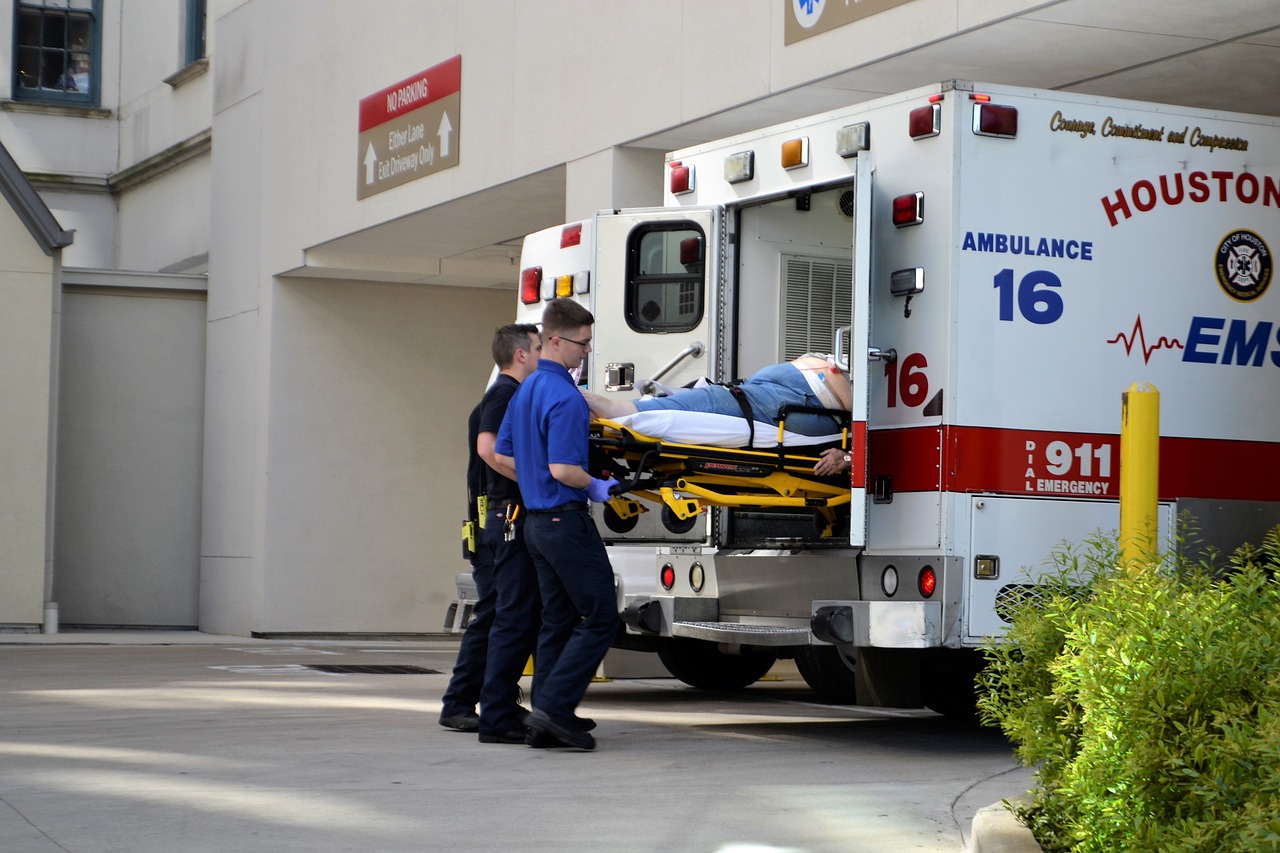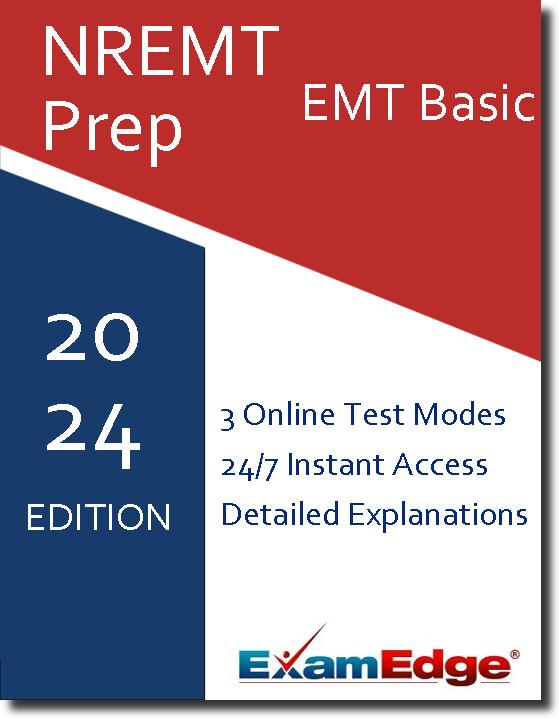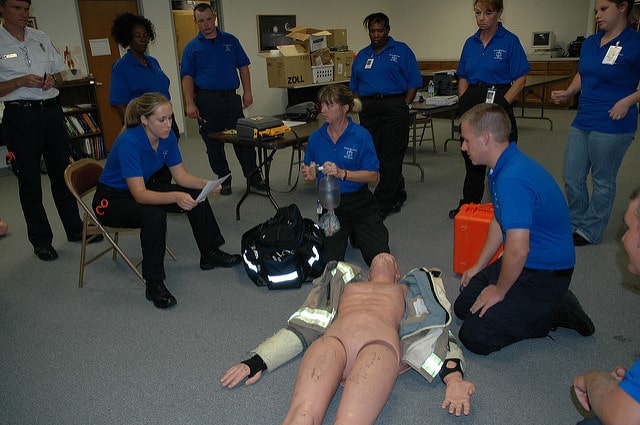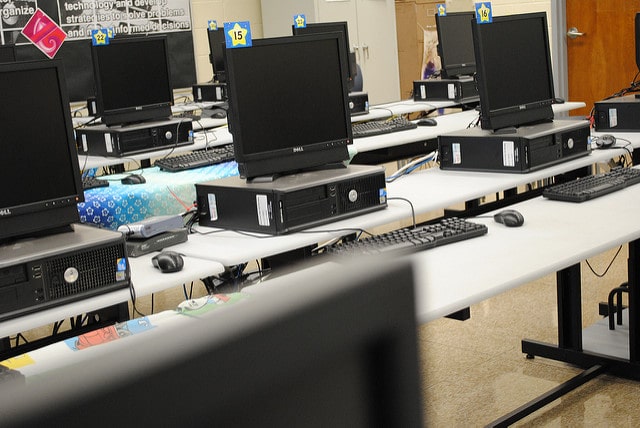Photo By: Aaron Smith
Used with permission via Creative Commons 2.0
What is the NREMT Exam?
Updated for 2021
In most states, the process for certification in the EMS field involves the National Registry. The Registry is a testing body that provides a standard of testing and many states use this body as a way to certify that an individual is qualified to possess an EMT or Paramedic level medical license in that state.
If you are considering a career in the field of Emergency Services then you will most likely need to familiarize yourself with the NREMT Exam.
What does NREMT stand for? The acronym stands for the National Registry of Emergency Medical Technicians and embodies all levels of the profession from Medical First Responder all the way to the level of Paramedic.
The NREMT is an organization that validates the training of EMS personnel and a benefit of belonging to this Registry is that in many cases it allows for easy transfer of licenses between states that use the Registry as their preferred validation method.
Be sure to check out our EMT Section for more articles and gear recommendations!
If you are looking to enhance your study environment then check out our Best Places To Study Article.
What does the NREMT exam entail?
Gone are the days of a standard paper test with a preselected bank of test questions. The NREMT is now a CAT or Computer Adaptive Test. Candidates will be subjected to between 75 and 140 questions.
These questions are drawn from banks that cover varying areas of EMS knowledge. Prospective EMTs and Paramedics should expect to receive testing on but not limited to Anatomy, Trauma, Respiratory, Obstetrics/Gynecology, Cardiology, and Acute Abdominal Illness and Injury.
Paramedic candidates are also tested on their knowledge of Pharmacology. Each question starts at an average difficulty and then adjusts depending on if the question was answered correctly or incorrectly.
After the candidate answers enough questions to determine competency in a subject area the CAT switches to a new subject area and the process starts anew.
The length of the test also varies. Some candidates only are given 75 questions while others take the entire 140. It is completely dependent on how many right answers are given.
For instance: an EMT prospect who really knows their material can pass the tests with minimal questions, while someone who is not prepared at all can also fail at 75 questions. Most people taking the exam will fall between the 75 and 140 question allotment.

The exam is difficult and many candidates do not pass during the first attempt. Most future EMTs pass the second or third time through. However, it should be noted that the Registry has a three-strikes rule.
If a prospect fails the exam three times than they have to repeat the entire class before they will be allowed to retest. The testing fee is also paid every time the EMT takes the test.
Considering the testing fee ranges from $65 to $110 depending on what level the candidate is testing at, it is advantageous for the person testing to pass the exam the first time through. At the end of this page, there will be resources listed to aid in passing the first time.
However, while aids help the best strategy is always diligent studying and learning the material. Treat this exam as if a loved one’s life depends on it because EMS personnel are involved in taking care of someone’s loved ones in real Life or Death situations.
The test is serious and the study habits of those taking it should be as well. Candidates should ask themselves: How qualified do I want an emergency person to be if they were treating my mother or father, brother or sister?
The second part of the exam is a practical skills evaluation. The purpose of this portion of the exam is to test the knowledge of EMTs to be in simulated real-life scenarios.
Candidates should become very familiar with the skill sheets that will be provided during class. Those looking for a sneak peek can find copies of the sheets at the NREMT website. These sheets are for Medical First Responders, EMT-Basics, and EMT-Paramedics.
While a number of skills seem overwhelming at first, repetition leads to perfection, and by the time candidates are prepared to take the NREMT Psychomotor portion of the Registry the skills will be like second nature.
In the field, EMTs do not have the luxury of thinking about how they should apply oxygen or perform CPR. The training takes over and they just act. The practical examination is meant to simulate real-world scenarios.
Candidates that fail the practical portion of the Registry exam only need to retest on the station they failed out on and do not have to retest the CAT (Computer Adaptive Test) portion.
Once again, however, if a candidate fails the psychomotor test 3 times then they are required to repeat the entire EMT class before they will be allowed to retest. They will also have to repeat the CAT portion as well.
The National Registry of Emergency Medical Technicians exam is a challenging test of the candidate’s knowledge and skill. It is difficult to pass.
However, given the nature of the work that EMS personnel perform, a difficult test is necessary to ensure quality and well-trained emergency personnel are on the road. Diligence and a working knowledge of the EMS field are required to pass this test.
Here are 33 Proven Tips to Pass the NREMT Exam.
What to do leading up to the NREMT Exam.
1. Use Test Simulation Software!

Used with permission via Creative Commons 2.0
The NREMT Exam is a computerized test. It adjusts the difficulty of the questions based on how the test taker is doing.
This can be intimidating to think about (at least it was for me). One of the biggest pieces of advice my instructor gave me was to take as many practice tests as possible.
Practice tests allow the EMS student to get a sneak peek on how the registry will be formatted. There are a couple of ways to accomplish finding practice tests.
One way is to use good old-fashioned Study Guides. The upside is they are relatively low cost and easy to order from places like Amazon or at brick and mortar stores such as Barnes and Noble.
They are also portable, students can bring them on daily errands and study on the go. However, the drawback of these study guides is the fact that they are static. They will lead to just memorizing answers and this is not a good way to learn.
The NREMT does not draw from the same test bank as study guides. It is recommended that a student looks for an online testing company that has a huge bank of questions. This will allow the best possible chances of getting questions that are close to the registry style of questions.
For test simulation software I recommend Exam Edge. Exam Edge is an industry-leading exam preparation company that has been supplying hopeful professionals with practice exams since 2006.

Visitors to Exam Edge can take a free sample test to see if they like the software. Exam Edge does not require any software to be installed and every answer contains detailed explanations of why it is right or wrong.
Isn’t it better to be prepared for a test that will decide your immediate future?
Visitors to this site have an opportunity to save 10% if they use promo code SAVE-CJ10 when shopping for your NREMT Healthcare Certification Exam simply by following this link.
I do receive monetary compensation by recommending this product. However, I would not recommend Exam Edge unless I felt that taking practice tests would benefit future EMTs.
2. Listen to music

I have used this service for about 2 years now and it helps me greatly in my study habits. Studying for me and others like me is not the easiest at times.
Here is a personal story. As a kid, I grew up with ADHD. This is an attention killer. Even as an adult there are times I find it difficult to stay focused to study.
Something is always grabbing my attention. One of the best ways I found to study (for me anyway) is to listen to some sort of non-vocal music. It helps me zone in on what I am reading.
Granted this does not apply when I am reviewing audio notes. However, I used this technique to pass my classes at U of M as well as throughout my Paramedic class.
Business Insider and Tech Crunch, as well as many other press platforms, have given this service a thumbs up in their reviews, saying that it definitely improves focus and concentration.
How Focus@Will Works:
The results of an EEG (electroencephalographic) or “brainwave” study show that focus@will audio tracks tune people’s brains to frequencies associated with sustained, task-focused attention and thought (read the study results).
They saw a greater than 200-400% increase in focus time with focus@will. This was based on a survey of 22,000 of their most active users. Focus@Will saw dips in usage over the weekends, this means that subscribers are using focus@will primarily during work hours, and is a key measure of whether the system works.
Focus@Will asked their users to rate their productivity during each session, and they found that the average productivity in a one-hour focus@will session is 75% – this is far above the productivity most people report in an hour without focus@will.
Disclaimer time. I am recommending this product because I use it and has been a HUGE boost to my ability to study and my productivity. However, by recommending this product I will receive monetary compensation if you continue to use the product after its trial period is over.
–>Click on my link or the Banner Above to Get Started<–
3. Do not cram
Cramming is the most used study technique among students. However, it is the procrastinator study technique and it is one of the worse ways to learn.
As with previous sections on this list, repetition is key to learning information and retaining it. Remember the brain likes to keep the gist of what it learns. For example, students will learn all sorts of treatments for various ailments that EMTs will encounter during their careers.
However, without repetition, students will remember what they have to do but may forget some sections of how. A test like the national registry, it will ask questions that will want specifics, not the gist.
The practical section of the NREMT has a section for auto fails and if a student hits one of them they will have to retake the station. It is very important that candidates remember as much about patient treatment as they can and cramming will only hurt them.
https://www.psychologytoday.com/blog/memory-medic/201201/cram-or-not-cram-is-the-question
4. Take a practice test once a day. Take time to dissect the questions.
Repetition is the key to mastery. Take a test at least once a day. This will improve your chances at the registry by training your brain in preparation for the real test.
If the site you use for simulated NREMT tests has a timed option, start with untimed tests. With each question asked, take the time to look up the answer. Not only the right answer, but all to take the time to look up why the other answers are wrong.
For example:
What is the average normal blood pressure for a healthy adult?
a. 120/80
b. 80/40
c. 200/100
d. 140/70
The obvious answer is A. However, look at why the other answers are wrong and you will learn that a Blood pressure of 80/40 is extremely hypotensive to the point where your patient is in critical condition and experiencing shock.
200/100 is extremely hypertensive and could be an indicator that your patient is having a stroke or some other metabolic crisis.
140/70 is a pre-hypertension blood pressure value and could indicate that your patient could eventually need medication to correct this.
Look at all the information that was learned from this one question by dissecting each of the answers. Studying in this way will prepare students for the Registry Exam more so than any other study technique.
5. Practice your skill sheets
The second half of the NREMT exam revolves around the application of practical skills. This is the hands-on portion of the exam to test if candidates can physically perform the various tasks that emergency personnel have to master to do their jobs.
Most classes will provide students with the exact skill sheets that they will be graded on when they take their exams. It is important to pay attention to auto fails at the bottom of the sheets.
Get used to saying: “Is my scene safe?” and “I am taking proper BSI precautions.” Below are links to the official NREMT skill sheets. Print them, Learn them, Live them.
6. Practice med math (if paramedic)
Paramedics have the extra added burden of medical math. During the registry exam, they will be asked drug dosage questions and will have to figure out simple dosage and drip rate calculations.
Repetition is key to knowing different drug calculations and formulae. Take time to practice med math problems as part of your study routine.
Link: http://www.dosagehelp.com/practice_questions
7. Learn the Power of Chunking.
Chunking is breaking information down into more manageable bits. It is a study technique that allows the student to digest large amounts of information by grouping the information into sudo-categories.
For example, look at Paramedic Pharmacology. While a candidate can study all the meds at the same time, they will quickly find that they are overwhelmed by the amount of information.
By using the study method of chunking, students can just study the cardiac meds today and the respiratory drugs tomorrow. Break large amounts of information into more manageable chunks.
8. Know your anatomy
The knowledge of human anatomy and physiology is critical to success at the National Registry Exam. Students need to know what part of the body is where, how they work, how they are related, and how the various body systems interact with each other.
Khan Academy has an extensive library of free videos that go over the various body systems that EMS personnel will need to know. Best of all, all this information is free and taught in a classroom style that is easy to follow.
The site also features activities and flashcards with most of the lessons. Khan Academy is a complete learning platform that exists to empower students.
Candidates seeking to challenge the registry or to improve their working knowledge of Anatomy and Physiology should check this site out.
https://www.khanacademy.org/science/health-and-medicine
9. Space it out
Space out your study time. Study information over the course of a few days instead of one day. This will allow the neuropathways inside the brain to grow. It also gives the mind an opportunity to forget information.
When studying information, people tend to forget the particulars and remember the gist of what they read. By spacing study time out a student can reinforce what they learn by relearning information that the brain will naturally forget and strengthen neuropathways in ways that cement the information.
Space out when you study, ensure that you will go over the same information multiple times and you will be ready when the testing day comes.
10. Meditate

Used with permission via Creative Commons 2.0
Meditation has a wide variety of health benefits. It can help lower blood pressure, improves the immune system, improves mood. Meditation also helps in studying by helping clear away the mental fog and enhancing mental clarity.
Harvard recently published a study on meditation’s effects on the brain. According to the study, meditation actually reshapes our brains, improves memory, and provides great mental benefits.
Adding meditation to a daily routine is not only good for helping students seeking to challenge the NREMT exam, but it can also improve life in general.
http://www.artofliving.org/us-en/meditation/meditation-for-you/benefits-of-meditation
11. Take breaks
Study breaks are a very useful asset. They let the student digest and clear that mind foggy feeling after staring at a page full of words for too long. The problem with study breaks is that it can lead to procrastination.
Taking proper study breaks can be very beneficial to the learning process. Brainscape has an article on the proper method of taking a study break. According to that article, this is the proper method of taking a study break, when to do it, and what not to do during one.
When taking a study break, DO:
- Periodically schedule breaks for short amounts of time in between your studying.
- STICK to your schedule. Not a minute more!
- Remember to EAT. Not junk food on which you’ll snack the whole time you study. But take 20 minutes to cook yourself a real meal and sit down and eat it. Food for thought, anyone?
- Take time to exercise! Exercising not only works out your body—it will also stimulate your brain, making your study session far more effective.
- Read a book or an interesting article in a magazine unrelated to your test material.
DO NOT:
- Tell yourself that you will check your Facebook/e-mail for 15 minutes then take half an hour instead.
- In fact, don’t check your email or Facebook at all while you’re studying!
- Start a new TV show (especially the week before finals). The TV provides an ENDLESS supply of material for procrastination. You will get sucked into a new series and then you will have to watch all 6 seasons, and before you know it will have been a week since you left your apartment, and your boss is calling you every hour wondering where you are. Enough said.
- Do not take a nap for more than 20 minutes. Otherwise, you might find yourself spending more time dreaming about doing well on exams than actually doing well on exams.
Read the full article at:
https://www.brainscape.com/blog/2011/06/study-break/
12. Write it out
If you are starting to notice a trend in the article good for you. Repetition is the key to encasing information in the mind for long-term storage.
The reason why note-taking has been the go-to learning method since the dawn of learning is that writing something down engages the brain. Hearing information activates certain parts of the brainwriting activates different regions.
Together these regions strengthen the growing neuropathways that store the information. Then when the student returns to read the information they wrote down it further reinforces the information they seek to remember.
For instance, it is much better for paramedic students to make their own Drug Study Cards, as opposed to purchasing their own. Writing down the information on drug dosing and other drug-related information will reinforce the data into memory and make it easier to remember it when test day comes.
http://www.lifehack.org/articles/featured/writing-and-remembering-why-we-remember-what-we-write.html
13. Study in groups
Study groups are an excellent way to reinforce learning. One of the most effective ways of learning is actually by teachings. For example, one student really knows his cardiology while other students struggle with this subject.
However, that student is really on point with his pharmacology. By forming a study group with these two students, they can quiz each other and build up weaknesses in knowledge.
There should be caution when joining a study group, however. It can be very easy to get distracted by talking about non-study related material. Bullshitting is fun, but students should keep their eye on the prize.
For tips on how to get the most out of your study group check out: http://blogs.einstein.yu.edu/8-tips-for-getting-the-most-out-of-study-groups/
14. Roleplay
Not that kind of Roleplay! The NREMT exam likes to ask scenario-based questions. One of the best ways to study is to put yourself in these scenarios. During class, your instructor will assign a student as a patient and others as caregivers.
This is not far off of being a role-playing game. Instead of a warrior class, your class is EMT or Paramedic. Instead of slaying dragons or looting epic treasure, you are slaying the mighty arrhythmia or stopping the evil hypoglycemia monster.
This is a perfect activity to employ with a study group. EMS scenarios are plentiful online and everything is included to run them. They provide the scene, how many patients, what’s wrong with the patient, recommended treatment options and whatnot.
Roleplay scenarios. http://www.sremsc.org/PDFs/State_EMT_Training_Scenarios.pdf
15. Find a mentor to quiz you
Most people getting into EMS have friends that are already EMTs or Paramedics. These friends have already been through the registry and can help quiz prospectives on their material. Mentors will have the candidates’ best interests in mind.
16. Read out loud, record it
Reading information out loud reinforces memory. The more ways that a student can find to reinforce information the stronger the memories become. Using a digital recorder to not only take notes but replay them back is an inexpensive way to further education.
The more ways a person can find to take in information the more ways that information is reinforced in the mind. Repetition is key, a theme this article has and will repeat throughout this list.
17. Take a hike

Used with permission via Creative Commons 2.0
Sometimes, hardcore studying will run the mind down. Students will get mind fog and find it harder and harder to study effectively. One of the best ways to re-engage the mind is to give it a break.
Put the books down, head to a local metro, state, or federal park, and take a hike. Physical activity has been shown to improve the ability to pay attention. This is accomplished by increasing blood flow to the brain.
Some readers might have already noticed this effect. I know when I am trying to think, I get up and pace a bit. The physical activity helps me think. I also enjoy hiking. Studies have shown that forests and other natural scenery have a calming effect on the mind and can improve mood and concentration as well.
18. Caffeine
Caffeine has been shown to improve the ability to recall and remember information. Limit caffeine intake to 1 cup of coffee. Too much caffeine and students can experience anxiousness and jitters, which can make it difficult to concentrate when trying to study.
According to the study at John Hopkins, people given caffeine after seeing information had better recall the next day. Read the full article at http://hub.jhu.edu/2014/01/12/caffeine-enhances-memory.
19. Kill distractions
How’s Facebook? Twitter? Instagram? Snapchat? The typical student belongs to these social networks and more. Not only are they bombarded with information from every angle they are also constantly finding more sources of this information.
The advent of smartphones has compounded this problem. Where it used to take a computer to access these feeds, now almost every person has the ability to check social media in their pockets. This is horrible for productivity.
The modern world contains an uncountable amount of distractions that can impede a student’s ability to make the most of their study time. Most of us will check out phones or have a separate browser open to check Facebook or other social media sites.
In a world full of distractions, students have to make a conscious effort to kill distractions. Shut that phone off, close that extra browser, and resist the siren call of social media and other distractions.
Need help? Below is an article that provides tips on how to eliminate distractions and raise productivity.
http://dewiragi.com/12-tips-kill-distractions/
20. Relax the day before
Students should know their material by now. The day and night before the exam should include light studying to reinforce the area’s the student feels they are lacking. Spend the rest of the day relaxing.
If students need to cram at this point then they have not spent the proper time preparing for the exam and should not be surprised if the results are less than stellar.
http://learnenglishteens.britishcouncil.org/exams/exam-study-tips/night-exam
What to do on Test Day

Used with permission via Creative Commons 2.0
21. Have a Backup Alarm
The worst possible scenario that can happen on test day is waking up late, rushing to the testing site, and being denied entry because you are late. This is a situation that is completely avoidable by having a second alarm.
Most of us use our phones, why not set multiple alarms. If you are rocking an old school alarm clock at your bedside, make sure it has a fresh backup battery in case of a power failure.
22. Don’t Panic
“I must not fear. Fear is the mind-killer. Fear is the little-death that brings total obliteration. I will face my fear. I will permit it to pass over me and through me. And when it has gone past I will turn the inner eye to see its path. Where the fear has gone there will be nothing. Only I will remain.”
If at this point, students have been studying their material (instead of cramming), then they should know everything they will need to pass the NREMT exam.
Don’t panic, treat the NREMT as any practice test you have taken so far. At this point, you should have no problem, provided you know your material.
23. Eat your Wheaties
If you break up the word -breakfast- you have two words, break and fast. Fasting is an extended period of time where a body goes without food. During the night your body, obviously, doesn’t intake any food.
This in turn forces to body to operate during nighttime hours on its supply of glucose. Breaking the fast in the morning helps to normalize blood sugar and can improve cognition as the brain is always hungry for sugars.
On test day, make sure that you get up early enough to have a good breakfast. Also, drink a cup of coffee to gain the benefits of caffeine mentioned earlier.
http://everydaylife.globalpost.com/important-eat-breakfast-before-test-24179.html
24. Ask Why an Answer is Wrong
This goes all the way to tip number 2. If students have been using the question dissection method then they will be familiar with this tip. Weed out all the wrong answers on questions that you get stuck on.
Eventually, all that will remain will be the most correct answer. Now this being said typically there will be two right answers in questions. Select the most right. This will come into play with why an answer can be wrong. For example:
Treatment for chest pain should include the following:
A: Morphine, Oxygen, Nitro, Asprin
B: Oxygen
C: IV, EKG, Morphine, Oxygen, Nitro, Aspirin
D: Rapid Transport to the nearest McDonalds because fries can lube coronary arteries.
Obviously, D is the throw away (see the next tip). A, B, and C are all correct treatments for Chest Pain, however, answer C is the most correct because it contains more interventions.
Find more test-taking strategies here: https://casc.byu.edu/testtaking-strategies
25. Identify the bad apple
Test questions usually have an obviously incorrect answer. Quickly identifying the obviously wrong answer will allow students to have to think about 3 possible correct answers. As with the example above, identify the wrong answer quickly.
26. Only Read the question
A common mistake student will make when looking at a question is reading too much into it. Read only the question and go off of the information it provides. Do not bring information from other questions or real-life situations into the presented question.
For example, if you are answering a question about leg pain and one of the answers is dealing with airway, then is most likely not what the question is looking for. Unless the question states that a patient is having issues breathing, they are not.
27. Reread the question and your answer
If you are unsure about a question, take the time to reread it and make sure the answer is the most correct answer. A common myth is that statically the first chosen answer is usually the correct one.
You will find an actual study below that dispels this myth. The TL:DR is that questions that have been reread and checked tend to be more correct than questions where students stayed with the first answer.
Take the time to make sure your answer is what you believe to be the most correct before moving on to the next question. On the Registry Computerized Exam, you will be unable to go back and correct an answer that might be shown in a future question. Make that mouse click count.
http://people.wku.edu/steven.wininger/Kruger%20First%20Instinct%20Myth.pdf
Tips to pass the NREMT Psychomotor Exam

Used with permission via Creative Commons 2.0
28. Go through the motions
Make sure you are familiar with each station of the exam. By now students should have had ample practice time. Example videos are easy to find on sites like YouTUBE. Below is a playlist of students performing on actual National Registry Station.
It should provide a good idea of what to expect when the big test day comes. Remember to study the skill sheets from tip 3.
https://www.youtube.com/watch?v=V8ocGIOPOhA&list=PLEQHlfcjPWKeqMcE_mpmWVmLP3OHCJ8bM
29. Think back to roleplay and study scenarios, read over the auto fails
Remember the scenarios from study groups and roleplay. This will be important when it comes time to test your patient assessment skills. While you are waiting to be called to a station read over the auto fails on your skill sheet.
If a student hits any of the listed failure criteria they will fail the station and have to repeat the entire station. Hit too many fails and you will have to retake the practical section of the NREMT. This, in turn, will cost you more money.
30. Ask for updated vitals frequently
Especially important during patient assessment stations. Ask for vitals frequently. The proctor will have to look at his paper, giving you time to think. As for vitals when you are unsure about the next step or treatment procedure. Be sure to write your vitals down.
31. Be confident
If you seem like you know what you’re doing the proctor is more likely to overlook miss steps. One of the pitfalls in the practical setting is that proctors will be assessing your confidence level as well as your knowledge.
If a student doesn’t seem like they know what they are doing then the proctor tends to grade them harder. This is just human nature. Approach the station as if you have already passed it.
Be confident with your treatment plans and should you forget something, the proctor is more likely to overlook it. Seem like you belong there.
32. Be a person
Introduce yourself, be friendly. Be a person. This is a simple concept. Proctors will usually have already tested plenty of students by the time it is your turn. Introduce yourself, ask them how they are doing, try, and be friendly.
Try this the next time you are in line at a fast-food restaurant. Just ask the clerk how their day is going and say hello, instead of just rattling off your order. Watch how they respond. Most likely they will smile and treat you like a person instead of a customer.
The same goes for your proctor on test day. If you approach them and just start the station, you are just another candidate to them. Introduce yourself, say hello, ask how their day is going. All of a sudden you become a person to them, someone that could be a friend.
33. Celebrate
Study hard, use some of these tips, and you will have a good chance of passing the NREMT on your first attempt. Remember that your fate is in your hands and if you do not pass the test it is no one’s fault but yours.
Sounds harsh but that’s the reality. That being said now that you have passed your Registry exam its time to celebrate!
If this article has been helpful to you then please comment, share, and subscribe!

